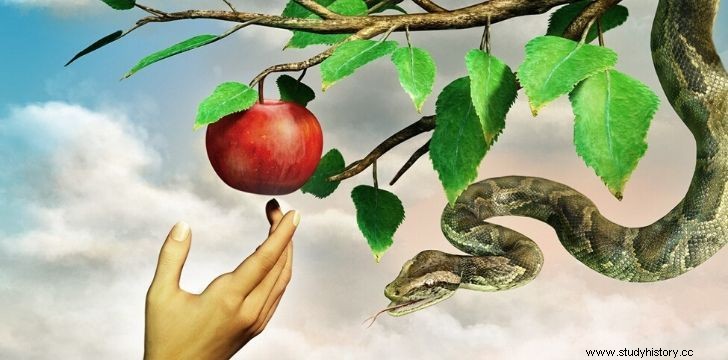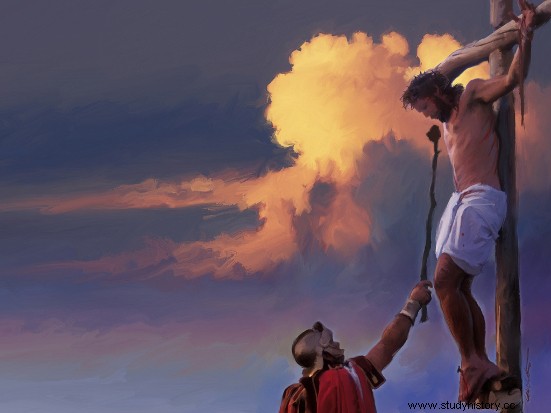Setting aside Mein Kampf of Hitler and the Red Book of Mao Zedong , because their figures must be quarantined and, in addition, it was mandatory to acquire them, today we will deal with the best-selling book in all of history:the Bible. In no case will I judge its content, I will simply deal with the translation or interpretation errors that have survived to this day and some editing errors that gave rise to funny or even blasphemous texts.

We'll start with Adam and Eve and the apple of discord.
According to Genesis, God put Adam and Eve in the Garden of Eden (paradise) and told them that they could eat the fruit of all trees except the so-called Tree of the Knowledge of Good and Evil. The serpent (the Devil) came tricked to Eve and ate the forbidden fruit (original sin). But nowhere does he say that the fruit was an apple. To find the apple we have to go to the Vulgate, a translation of the Hebrew and Greek Bible into Latin from the end of the 4th century made by Saint Jerome of Stridon by order of Pope Damasus I. The first official Bible. It was called the Vulgate because it is written in Vulgar Latin (the Latin of being at home that everyone spoke). In this Bible, malum (evil) was translated as apple, because malum in Latin also means apple. From this moment the forbidden fruit is identified with the apple. Centuries later, painters helped by placing an apple in Eve's hand.
Another mistranslation concerns the camel and the needle.
In the Gospel of Matthew, Jesus says:"It is easier for a camel to go through the eye of a needle than for a rich man to enter the Kingdom of Heaven." Obviously, it is impossible for a camel to pass through the eye of a needle, but do not think that the camel in this sentence is out of place.
If we go back to St. Jerome's Vulgate we will find the error. Kámilos (in Greek it is a rope, thick rope) was identified with kámelos (in Greek camel). And although it is also difficult for a rope to pass through the eye of a needle, it makes more sense than a camel.
I'm thirsty, and they gave him vinegar.
In the Gospel according to Saint John, in its chapter 19 it says:
Later, knowing that everything was already finished, and so that the Scripture would be fulfilled to the end, Jesus said:I thirst. There was a container full of vinegar there; they soaked a sponge in it, tied it to a sprig of hyssop, and held it to his mouth. After drinking the vinegar, Jesus said:«Everything has been fulfilled». And bowing his head, he gave up the spirit to him.

Without going into the intention of those who offered it or the meaning of Jesus' words beyond the literal, this story has to do with vinegar or, rather, with the supposed vinegar. What was a “bowl full of vinegar” doing there? The answer to this question is much simpler if we think that it was not vinegar, but posca. The posca was a drink that was made by mixing water and chopped or vinegared wine. Normally, it was the wine consumed by citizens who could not afford a superior quality and, above all, by the legions of Rome in their many campaigns of conquest throughout the known world. And even though it had a very unpleasant taste, it had several advantages over wine:it was very cheap, there was no risk of spoilage - it was already ground - and it was the safest way to drink water (the Egyptians used wine as an antiseptic and the Persians as a germicide). So, since Jesus Christ was guarded on the cross by Roman soldiers, it is easier to place a “container full of posca” than a “container full of vinegar” in this scene.
And moving on to the editing errors, we have the blasphemous comma.
The blasphemous comma :in several editions of the Bible of King James of England, an English translation of the Bible that was published in 1611 and that has been the reference for later translations, says:“And there were also two other malefactors [crucified with Jesus] ” should have been “And there were also two others, malefactors” so as not to include Jesus in that distinguished group.
The Bible of sinners or the wicked :refers to the Bible published in 1631 by Robert Barker and Lucas Martin in London. The name given to this Bible is due to the omission of the word “not”:in the Ten Commandments, “You shall commit adultery” appears instead of “You shall not commit adultery“. The Bible publishers were fined £300 and deprived of their printing licence. Today, there are 11 copies of this edition.
The Bible of the unjust :this is the name given to a Cambridge edition in 1653. In the first letter to the Corinthians he says:“Do you not know that the unjust will inherit the kingdom of God?”, instead of “Do you not know that the unjust will not inherit the kingdom of God?". Publishers fined three thousand pounds.
The Camel Bible :In this 1823 English edition, "Rebekah and her camels arose", instead of "Rebekah and her damcels arose".
The Printer's Bible :This is a published edition from 1702. In Psalm 119, it says “The printers have persecuted me without a cause“, instead of “The princes (princes) have persecuted me without a cause“.
The Vinegar Bible :version published at Oxford in 1717, by J. Baskett. Turns the “parable of the vine or vineyard (vineyard)” into the “parable of the vinegar (vinegar)“.
The Owl Bible :1944 edition, reads:“…women were subject to their owl husbands” instead of “…women were subject to their own (own) husbands“.
The Bible of those responsible :1562 edition published in Geneva in the Gospel according to Saint Matthew:“Blessed are the craftsmen of the place (place-makers)“, instead of “Blessed are the peacemakers (peacemakers)“.
And we ended with a miracle that, anyway, was not such.
In the Gospel of John, Jesus, his mother and his disciples attended a wedding in Cana of Galilee in which, it seems, there were more guests than expected or they drank more wine than normal for this type of celebration . Faced with this critical situation for the groom, Jesus ordered six clay pots to be filled with water, which when they were brought to the table... a miracle took place:the water turned into wine, and a good one.
At the time this gospel was written - the end of the 1st century - there was already a device that could turn water into wine. The artist Heron of Alexandria, the Leonardo da Vinci of Antiquity, invented the first steam engine, the vending machine, various automatons... and the magic jug.

The jug is divided into two halves horizontally. The piece that divides the jug into two halves has small holes (E) along the wall and a larger one in the center crossed by a tube that runs from the bottom to the handle with an exit hole at thumb height (K ). Out of sight of the diners, we pour wine into the jug that will fill the lower half through the holes (E). Once in the living room, we say that we are going to turn the water into wine and pour water into the pitcher, making sure to cover the hole with our thumb. As there is no air outlet, the water will be trapped at the top. Keeping the hole covered with the thumb, the jug is turned over and pure water will come out… we say that it is a slow process. We repeat the operation but this time we do not cover the hole, the water will continue to come out but already mixed with some of the wine that has passed through the holes (E)... it is already taking on color and flavour. And we finish off by serving again, when the water from the top is finished, obtaining wine. Of course, the quality of the wine will depend on what we have added at the beginning. Logically, and by reversing the process, wine can be turned into water, although with this miracle we would not make many friends.
